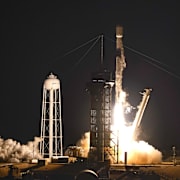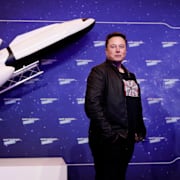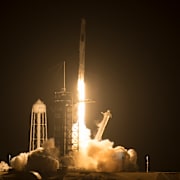
Månfarkosten Orion slog ner i havet – ”förtjänar A+”
Nasas obemannade rymdfarkost Orion landade i Stilla havet på söndagskvällen, rapporterar flera medier. Därmed har den första rymdfärden i det nya Artemisprogrammet genomförts. Av en tillfällighet avslutades expeditionen på 50-årsdagen av det senaste tillfälle Nasas astronauter beträdde månen, i samband med att Apollo 17 landade på himlakroppen.
– Om du skulle be mig att betygsätta det här så skulle jag säga att vi förtjänar ett A+. Vi har lärt oss hur rymdfarkosten fungerar och vi har lärt oss att flyga den här fantastiska maskinen, säger Nasas Cahtherine Koerner till New York Times.
Artemis I befann sig i rymden under 26 dagar.
bakgrund
Rymdfarkosten Orion
Wikipedia (en)
Orion (officially Orion Multi-Purpose Crew Vehicle or Orion MPCV) is a partially reusable crewed spacecraft used in NASA's Artemis program. The spacecraft consists of a Crew Module (CM) space capsule designed by Lockheed Martin and the European Service Module (ESM) manufactured by Airbus Defence and Space. Capable of supporting a crew of six beyond low Earth orbit, Orion can last up to 21 days undocked and up to six months docked. It is equipped with solar panels, an automated docking system, and glass cockpit interfaces modeled after those used in the Boeing 787 Dreamliner. A single AJ10 engine provides the spacecraft's primary propulsion, while eight R-4D-11 engines, and six pods of custom reaction control system engines developed by Airbus, provide the spacecraft's secondary propulsion. Although compatible with other launch vehicles, Orion is primarily intended to launch atop a Space Launch System (SLS) rocket, with a tower launch escape system.
Orion was originally conceived in the early 2000s by Lockheed Martin as a proposal for the Crew Exploration Vehicle (CEV) to be used in NASA's Constellation program. Lockheed Martin's proposal defeated a competing proposal by Northrop Grumman and was selected by NASA in 2006 to be the CEV. Originally designed with a service module featuring a new "Orion Main Engine" and a pair of circular solar panels, the spacecraft was to be launched atop the Ares I rocket. Following the cancellation of the Constellation program in 2010, Orion was heavily redesigned for use in NASA's Journey to Mars initiative; later named Moon to Mars. The SLS replaced the Ares I as Orion's primary launch vehicle, and the service module was replaced with a design based on the European Space Agency's Automated Transfer Vehicle. A development version of Orion's CM was launched in 2014 during Exploration Flight Test-1, while at least four test articles have been produced. Orion was primarily designed by Lockheed Martin Space Systems in Littleton, Colorado. As of 2022, three flight-worthy Orion spacecraft are under construction, with one completed and an additional one ordered, for use in NASA's Artemis program.
The first completed unit, CM-002, was launched on November 16, 2022 on Artemis 1.
Omni är politiskt obundna och oberoende. Vi strävar efter att ge fler perspektiv på nyheterna. Har du frågor eller synpunkter kring vår rapportering? Kontakta redaktionen



